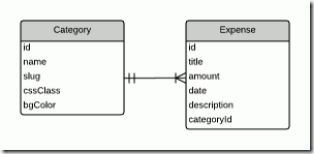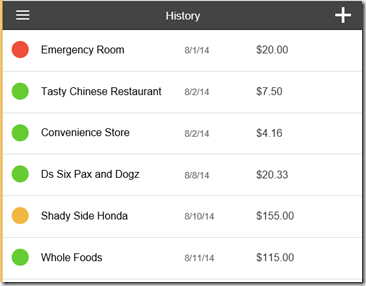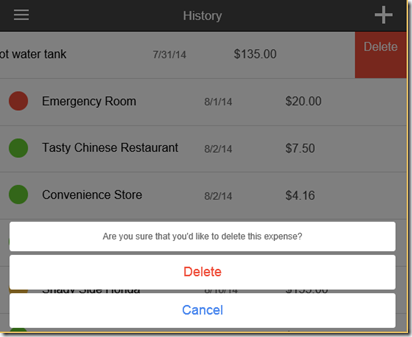Mobile first! Wijmo 5 + Ionic Framework之:费用跟踪 App
费用跟踪利用采取了Wijmo5和Ionic Framework创建,目的是构建1个hybird app。
我们基于《Mobile first! Wijmo 5 + Ionic Framework之:Hello World!》的环境,将在本教程中完成费用跟踪App的构建。下面的代码结构是本教程完成要到达的效果,请预先创建好文件和目录。
www/ --> 工程根目录 index.html --> app 布局文件 (主HTML文件) css/ --> css 目录 js/ --> javascript 目录 app.js --> 主模块 app.routes.js --> 主路由模块 controllers/ --> app控制器目录 models/ --> app模块目录 services/ --> app 数据Service目录 templates/ --> angularJs视图代码目录(通过UI-Router调用) lib/ --> 第3方类库, 包括Ionic, Wijmo, jQuery等
数据模型(Data Model)
在费用跟踪App中,我们先要创建Data Model,E-R图以下

- Category:开支分类
- Expense:开支记录
- Budget: 预算(下面会用到)
在代码中,我们需要在www/js/services构建AngularJs Services来对数据模型进行建模。我们会用到HTML5的localStorage进行数据本地存储, 采取的格式为JSON。 需要注意的是,HTML5本地存储只能存字符串,任何格式存储的时候都会被自动转为字符串,所以读取的时候,需要自己进行类型的转换。目前我们实现的是HTML5 本地存储,有兴趣的读者还可移植为RESTful API、SQLite等数据存储方法。
运行demo后,通过Chrome调试查看的本地存储截图:

阅读开支历史记录
在开支历史页面中,提供了2个功能:阅读开支历史记录、删除开支记录。为了实现这些功能,在wwwjscontrollershistory.js文件中,添加以下代码:
//从localStorage取得开支数据 $scope.expenses = ExpenseSvc.getExpensesWithCategory();
这行代码提供了返回本地存储的开支记录。ExpenseSvc 服务,不但返回了开支对象,同时也返回了开支分类。基于这些数据,在
www emplateshistory.tpl.htm文件中,在ion-context指令内添加Ionic的ion-list指令,代码以下:
<ion-view title="History"> <ion-nav-buttons side="right"> <a class="button button-icon icon ion-plus" href="#/app/create"></a> </ion-nav-buttons> <ion-content class="has-header"> <ion-list> <ion-item ng-repeat="expense in expenses | orderBy:'date':reverse track by expense.id" class="item item-icon-left"> <i class="icon ion-record {{ expense.category.cssClass }}"></i> <div class="row"> <div class="col⑸0"> <h2>{{ expense.title }}</h2> </div> <div class="col⑵5"> <small class="light-grey">{{ expense.date | date: 'shortDate' }}</small> </div> <div class="col⑵5"> {{ expense.amount | currency }} </div> </div> </ion-item> </ion-list> </ion-content> </ion-view>
ion-list指令,用于生成排序的HTML列表,其子标签ion-item指令用于生成HTML列表项。 在ngRepeat指令中,我们使用了“track by”,目的是在对开支集合修改时提升性能,相干教程可参考博客《Using Track-By With ngRepeat In AngularJS 1.2 》。
现在添加删除开支记录按钮,用于向左滑动出现删除按钮、点击删除可删除开支记录。
在ion-item标签关闭前添加ion-option-button标签,代码以下:
<ion-option-button class="button button-assertive" on-tap="confirmDelete(expense.id)">Delete</ion-option-button>
ion-option-button 是Ionic提供的另外一个指令,用于在ion-item指令内试用。默许的,ion-option-button 是隐藏的,当在ion-item内向左滑动,则按钮会可见。这个功能特别对小屏幕装备非常重要。另外,还可通过该指令内置的can-swipe来实现对这个权限的管理--如有的用户不允许删除操作权限。
在删除函数中(控制器),可看到代码片断以下:
function confirmDelete(expenseId) {
// delete expense by its id property
$scope.expenses = ExpenseSvc.deleteExpense(expenseId);
}通过这个代码,我们调用ExpenseSvc服务的deleteExpense进行删除指定的开支记录(expenseId),同时这个方法也会返回开支记录集适用于更新页面数据。在真实的场景中,删除记录返回全部集合不是最理想的,但在此处我们用于演示说明。可动手试着删除几行数据试试。

另外,在删除这类比较危险的操作中,应当需要添加对话框再次提示1下用户。这里我们使用了Ionic提供的$ionicActionSheet service服务来实现。更新wwwjscontrollershistory.js控制器代码的confirmDelete函数以下:
//删除开支记录 $scope.confirmDelete = function (expenseId) { //ionic的 确认对话框 // show()函数返回了1个函数,用于隐藏actionSheet var hideSheet = $ionicActionSheet.show({ titleText: 'Are you sure that you'd like to delete this expense?', cancelText: 'Cancel', destructiveText: 'Delete', cancel: function () { // 如果用户选择cancel, 则会隐藏删除按钮 $ionicListDelegate.closeOptionButtons(); }, destructiveButtonClicked: function () { // 通过id删除开支记录 $scope.expenses = ExpenseSvc.deleteExpense(expenseId); // 隐藏对话框 hideSheet(); } }); };
ionicActionSheet服务提供了自定义接口,可实现各种提示对话框。上面代码实现的提示对话框效果截图以下:

创建开支记录
点击History页面右上角的![]() 可实现手工创建1条新的开支记录。在www emplatescreateExpense.tpl.htm文件中,代码以下:
可实现手工创建1条新的开支记录。在www emplatescreateExpense.tpl.htm文件中,代码以下:
<ion-view title="Create"> <ion-content class="has-header padding"> <form name="frmCreate"> <div class="custom-form-list list"> <label class="item item-input"> <i class="icon ion-alert-circled placeholder-icon assertive" ng-show="!frmCreate.title.$pristine && frmCreate.title.$invalid"></i> <input name="title" type="text" placeholder="Title" ng-model="expense.title" ng-maxlength="55" required> </label> <wj-input-number value="expense.amount" min="0" step="5" format="c2"></wj-input-number> <wj-calendar value="expense.date"></wj-calendar> <wj-combo-box items-source="categories" display-member-path="htmlContent" selected-value-path="id" selected-value="expense.categoryId" is-editable="false" is-content-html="true"></wj-combo-box> <label class="item item-input"> <textarea placeholder="Description" ng-model="expense.description"></textarea> </label> </div> <div class="button-bar"> <button type="button" class="button button-dark icon-left ion-close" on-tap="cancel()">Cancel</button> <button type="button" class="button button-balanced icon-left ion-checkmark" on-tap="addExpense()" ng-disabled="frmCreate.title.$invalid">Save</button> </div> </form> </ion-content> </ion-view>
这里使用ion-view 和 ion-content 指令进行内容展现。然后再添加Form,用ng-show指令验证输入内容---Wijmo的指令已在输入门限做了限制,故不需要验证。同时Wijmo Calendar 和InputNumber应当是自解释,ComboBox中可能不是。
ComboBox关联数据模型中的开支分类,我们通过其itemsSource属性进行数据绑定。ComboBox的displayMemberPath 用于设置显示内容,selectedItem的selectedValue用于选择开支分类的id属性。
在createExpense 控制器中,可看到以下的代码片断:
// 初始化Expense object $scope.expense = new Expense('', 0, new Date(), '', null); // 取得HTML类型的开支分类 $scope.categories = CategorySvc.getCategoriesWithHtmlContent(); // 用localStorage存储开支数据 $scope.addExpense = function () { // insert expense ExpenseSvc.insertExpense($scope.expense); $scope.cancel(); }; // 取消方法 (如,可回到主页面) $scope.cancel =
上一篇 前端基础――CSS+DIV布局
下一篇 程序编写中的细节问题